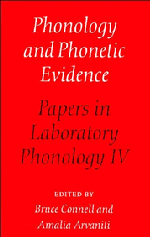Book contents
- Frontmatter
- Contents
- List of contributors
- Acknowledgments
- 1 Introduction
- I Features and Perception
- II Prosody
- III Articulatory Organization
- 15 Prosodic patterns in the coordination of vowel and consonant gestures
- 16 “Where” is timing? Comments on Smith
- 17 Asymmetrical prosodic effects on the laryngeal gesture in Korean
- 18 On a gestural account of lenis stop voicing in Korean: comments on Jun
- 19 A production and perceptual account of palatalization
- 20 An acoustic and electropalatographic study of lexical and postlexical palatalization in American English
- 21 What do we do when phonology is powerful enough to imitate phonetics? Comments on Zsiga
- 22 The influence of syntactic structure on [s] to [∫] assimilation
- 23 Assimilation as gestural overlap: comments on Hoist and Nolan
- 24 Orals, gutturals, and the jaw
- 25 The role of the jaw — active or passive? Comments on Lee
- 26 The phonetics and phonology of glottalized consonants in Lendu
- 27 Lendu consonants and the role of overlapping gestures in sound change: comments on Demolin
- Subject index
- Index of names
- Index of languages
17 - Asymmetrical prosodic effects on the laryngeal gesture in Korean
Published online by Cambridge University Press: 03 May 2011
- Frontmatter
- Contents
- List of contributors
- Acknowledgments
- 1 Introduction
- I Features and Perception
- II Prosody
- III Articulatory Organization
- 15 Prosodic patterns in the coordination of vowel and consonant gestures
- 16 “Where” is timing? Comments on Smith
- 17 Asymmetrical prosodic effects on the laryngeal gesture in Korean
- 18 On a gestural account of lenis stop voicing in Korean: comments on Jun
- 19 A production and perceptual account of palatalization
- 20 An acoustic and electropalatographic study of lexical and postlexical palatalization in American English
- 21 What do we do when phonology is powerful enough to imitate phonetics? Comments on Zsiga
- 22 The influence of syntactic structure on [s] to [∫] assimilation
- 23 Assimilation as gestural overlap: comments on Hoist and Nolan
- 24 Orals, gutturals, and the jaw
- 25 The role of the jaw — active or passive? Comments on Lee
- 26 The phonetics and phonology of glottalized consonants in Lendu
- 27 Lendu consonants and the role of overlapping gestures in sound change: comments on Demolin
- Subject index
- Index of names
- Index of languages
Summary
Introduction
It is well established that prosody conditions segmental and suprasegmental features. In English, for example, segments are lengthened at the end of a phrase (e.g. Oiler, 1973; Beckman & Edwards, 1990), and the “gestural magnitude” of /h/ is weakened word medially or in deaccented words (Pierrehumbert & Talkin, 1992). Additionally, Keating, Linker & Huffman (1983) show that many languages have different allophones for voiced or voiceless stops depending on position within the word or the phrase. However, such effects are often not symmetrical with respect to the edges of a prosodic unit. For example, in German, voiced stops often become voiceless word initially as well as word finally, but this causes neutralization only word finally, where the contrasting voiceless stop is not aspirated.
Korean also has such prosodically conditioned strengthenings and weakenings of laryngeal features, and asymmetries between word initial and word final position. In syllable initial position, there is a three-way contrast among aspirated, tense, and lenis voiceless obstruents, but this contrast is preserved only in the initial position of a word in isolation. In word medial onset position, the lenis stops are voiced between sonorants. In syllable final position, the distinction is neutralized completely to an unreleased lenis stop. The weakening processes in word medial and syllable final position have been described by phonologists (e.g. Cho, 1987; Kim-Renaud, 1974; Kang, 1992) as Lenis Stop Voicing and Coda Neutralization, respectively.
- Type
- Chapter
- Information
- Phonology and Phonetic EvidencePapers in Laboratory Phonology IV, pp. 235 - 253Publisher: Cambridge University PressPrint publication year: 1995
- 34
- Cited by

